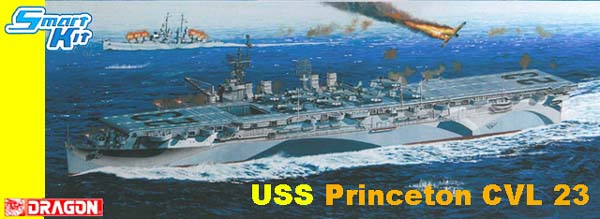
Reviewed by Timothy Dike February 2012

| History
The fourth Princeton was laid down as Tallahassee (CL–61) by the New York Shipbuilding Corp., Camden, N.J., 2 June 1941; reclassified CV–23 on 16 February 1942; renamed Princeton 31 March 1942; launched IS October 1942; sponsored by Mrs. Harold Dodds; and commissioned at Philadelphia 25 February 1943, Capt. George R. Henderson in command. Following shakedown in the Caribbean, and reclassification to CVL–23 on 15 July 1943, Princeton, with Air Group 23 embarked, got underway for the Pacific. Arriving at Pearl Harbor 9 August, she sortied with TF 11 on the 25th and headed for Baker Island. There she served as flagship, TG 11.2 and provided air cover during the occupation of the island and the construction of an airfield there, 1–14 September. During that time her planes downed Japanese “Emily” reconnaissance planes and, more important, furnished the fleet with photographs of them. Completing that mission, Princeton rendezvoused with TF 15, conducted strikes against enemy installations on Makin and Tarawa, then headed back to Pearl Harbor. In mid October she sailed for Espiritu Santo where she joined TF 38 on the 20th. With that force she sent her planes against airfields at Buka and Bonis on Bougainville (1–2 November) to diminish Japanese aerial resistance during the landings at Empress Augusta Bay. On the 5th and 11th her planes raided Rabaul and on the 19th, with TF 50, helped neutralize the airfield at Nauru. Princeton then steamed northeast, covered the garrison groups enroute to Makin and Tarawa, and after exchanging operational aircraft for damaged planes from other carriers got underway for Pearl Harbor and the west coast. Availability at Bremerton followed and on 3 January 1944 Princeton steamed west. At Pearl Harbor she rejoined the fast carriers of TF 50, now designated TF 58. On the 19th she sortied with TG 58.4 for strikes at Wotie and Taroa (29–31 January) to support amphibious operations against Kwajalein and Majuro. Her planes photographed the next assault target, Eniwetok, 2 February and on the 3rd returned on a more destructive assignment; the demolition of the airfield on Engebi. For 3 days the atoll was bombed and strafed. On the 7th Princeton retired to Kwajalein only to return to Eniwetok on the 10th–13th and l6th–28th, when her planes softened the beaches for the invasion force, then provided air cover during the assault and ensuing fight. From Eniwetok Princeton retired to Majuro, thence to Espiritu Santo
for replenishment. On 23 March she got underway for strikes against enemy
installation and shipping in the Carolines. After striking the Palaus,
Woleai and Yap, the force replenished at Majuro and sortied again 13 April.
Steaming to New Guinea, the carriers provided air cover for the Hollandia
operation (21–29 April), then crossed back over the International Date
Line to raid Truk (29–30 April) and Ponape (I May).
On 11 May Princeton returned to Pearl Harbor only to depart again on the 29th for Majuro. There she rejoined the fast carriers and pointed her bow toward the Marianas to support the assault on Saipan. From 11–18 June she sent her planes against targets on Guam, Rota, Tinian, Pagan, and Saipan, then steamed west to intercept a Japanese fleet reported to be enroute from the Philippines to the Marianas. In the ensuing Battle of the Philippine Sea, Princeton's planes contributed 30 kills and her guns another 3, plus 1 assist, to the devastating toll inflicted on Japan's naval air arm. Returning to the Marianas, Princeton again struck Pagan, Rota and Guam, then replenished at Eniwetok. On 14 July she got underway again as the fast carriers returned their squadrons to the Marianas to furnish air cover for the assault and occupation of Guam and Tinian. On 2 August the force returned to Eniwetok, replenished, then sailed for the Philippines. Enroute its planes raided the Palaus, then on 9–10 September struck airfields on northern Mindanao. On the 11th they pounded the Visayas. At mid month the force moved back over the Pacific chessboard to support the Palau’ offensive, then returned to the Philippines to hit Luzon, concentrating on Clark and Nichols fields. The force then retired to Ulithi and in early October bombed and strafed enemy airfields, installations and shipping in the Nansei Shoto and Formosa area in preparation for the invasion of the Philippines. On the 20th, landings were made at Dulag and San Pedro Bay, Leyte. Princeton, in TG 38.3, cruised off Luzon and sent her planes against airfields there to prevent Japanese land based aircraft attacks on Allied ships massed in Leyte Gulf. On the 24th however enemy planes from Clark and Nichols fields found TG 38.3 and reciprocated. Shortly before 1000 a lone enemy dive-bomber came out of the clouds above Princeton. At 1500 feet the pilot released his bomb. It hit between the elevators, crashed through the flight deck and hanger, then exploded. Initial fires soon expanded as further explosions sent black smoke rolling off the flight deck and red flames along the sides from the island to the stern. Covering vessels provided rescue and fire-fighting assistance and shielded the stricken carrier from further attack. At 1524 another, much heavier explosion, possibly the bomb magazine, blew off the carrier's stern and with it the after flight deck. Birmingham, alongside to fight fires, suffered heavy damage and casualties. Efforts to save Princeton continued, but at 1604 the fires won. Boats were requested to take off remaining personnel and shortly after 1706 Irwin began to fire torpedoes at the burning hulk. At 1746 Reno relieved Irwin and at 1749 the last, and biggest, explosion occurred. Flames and debris shot up 1000–2000 feet. Princeton's forward section was gone. Her after section appeared momentarily through the smoke. By 1750 she had disappeared, but 1,361 of her crew survived. Included in that number was Capt. John M. Hoskins, who had been prospective commanding officer of CVL–23 and lost his right foot with her, but who, despite the loss, would become the 1st commanding officer of the fifth Princeton (CV–37). Losses and damage to assisting vessels were heavy: Birmingham, 85 killed,
300 wounded, a heavily damaged topside, and loss of 2 5”, 2 40mm. and 2
20mm. guns; Morrison—foremast lost, portside smashed; Irwin-forward 5”
mounts and director out, starboardside smashed; and Reno; one 40mm. smashed.
Princeton earned 9 battle stars during World War II. Source DANSF
|
|||||||||||||||||||||||||||||||||||||
|
This latest kit from Dragon is a follow-up to the USS Independence CVL-22 kit. Many of the parts are the same between the two. Dragon has modified a few sprues and added a new one for the Princeton specific details. There is an extra sprue of both the F-6 Hellcats and TBF Avengers. An extra sprue featuring the 20mm guns has been added as well as new decals and instructions. |
|||||||||||||||||||||||||||||||||||||
| SPRUE A x2 | |||||||||||||||||||||||||||||||||||||
| An exciting addition to this kit is this sprue of deck tractors. There are two on the sprue and they include separate tires, and a hood and grill open on the sides so you can see the engine. There are two styles of tow bars to haul your aircraft around the deck. The tires are so detailed you can almost count the lug nuts on the wheels. The tires even have realistic tread. These are little models in themselves with incredible detail. | Click
images
to enlarge |
||||||||||||||||||||||||||||||||||||
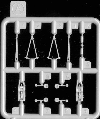 |
|||||||||||||||||||||||||||||||||||||
|
|||||||||||||||||||||||||||||||||||||
| SPRUE B x2 | |||||||||||||||||||||||||||||||||||||
| A couple of jeeps are included as well. They too have separate wheels and hood. These Jeeps feature nice seat detailing and even some underside drive train detailing. | 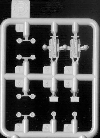 |
||||||||||||||||||||||||||||||||||||
|
|||||||||||||||||||||||||||||||||||||
| SPRUE D | |||||||||||||||||||||||||||||||||||||
| This sprue includes the main deck and hanger deck. The hanger deck walls feature interior bracing detailing and plenty of external details. The openings have separate roll-up doors in plastic and optional photo etched ones. Also on this sprue are the propeller and rudder assemblies. The latter are made in two pieces so that you can accurately pivot the rudder at the hinged joint. | |||||||||||||||||||||||||||||||||||||
|
|||||||||||||||||||||||||||||||||||||
| SPRUE E | |||||||||||||||||||||||||||||||||||||
| Gun tubs for the 20 mm and 40 mm anti aircraft guns are included on this sprue. Note the thin splinter shields around the gun tubs, very nice for plastic. Slides are used to give the radar mount 3 sided detail without visible seams. Slides also give the air intakes exceptional detailing. |  |
||||||||||||||||||||||||||||||||||||
|
|||||||||||||||||||||||||||||||||||||
| SPRUE F | |||||||||||||||||||||||||||||||||||||
| The funnels are nicely molded in two main parts. When I test fitted these parts the first thing I noticed was the absence of a prominent seam. There is an exceptional amount of detailing on these parts. Even the interior portion of the funnel trunking is well detailed with nice rivet detailing. The elevators have very nice deck planking with accurate tie down strips. The elevator can be positioned at any point thanks to the elevator details. There is also some really nice girder work on for the main mast that is molded as fine as you can get away with in plastic. So nice that there is no need to replace these with photo etch. |  |
||||||||||||||||||||||||||||||||||||
|
|||||||||||||||||||||||||||||||||||||
| SPRUE G | |||||||||||||||||||||||||||||||||||||
| The bow and stern details are included here with this sprue. Gun tubs for the forward 40 mm and aft 5" 38 gun are included. The walls include nice open doorways and plenty of detailing. Slides in the mold are again used to achieve extra detail on a single part without extra seams. | 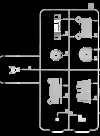 |
||||||||||||||||||||||||||||||||||||
|
|||||||||||||||||||||||||||||||||||||
| SPRUE H | |||||||||||||||||||||||||||||||||||||
| The island details are included on this sprue with impressive detailing. The rest of the mast girder work is included with that same thin girder work. Slides in the mold allow the main mast part to be molded as a single part. Equally impressive is the crane assembly with the open girder work comparable to photo etch parts. This is a vast improvement from the solid unappealing ones that are typically included. |  |
||||||||||||||||||||||||||||||||||||
|
|||||||||||||||||||||||||||||||||||||
| SPRUE I x2 | |||||||||||||||||||||||||||||||||||||
| This sprue features those roll-up hanger doors to close off the hanger. The funnel caps and handrails are molded with nice detail and as single pieces. Also included are lots of small details such as cable reels and fire hoses. |  |
||||||||||||||||||||||||||||||||||||
|
|||||||||||||||||||||||||||||||||||||
| SPRUE J x2 | |||||||||||||||||||||||||||||||||||||
| This sprue includes the rafts and float net baskets. Bits and closed chocks are molded finely. The anchors are very well done and include realistic separate stocks, really nice. The paravanes came out pretty good too. There are two of them included. |  |
||||||||||||||||||||||||||||||||||||
|
|||||||||||||||||||||||||||||||||||||
| SPRUE K x2 | |||||||||||||||||||||||||||||||||||||
| There are two of these sprues with these wood decked whale boats and 5" 38 cal open mounts. The whaleboat is the same one included in the Gearing kit and includes a separate rudder. Another nice item is this 5" 38 cal open mount. It includes separate yoke and breach assemblies and even a fuse setter. Detail is on par with even the best resin after market versions. | |||||||||||||||||||||||||||||||||||||
|
|||||||||||||||||||||||||||||||||||||
| SPRUE L | |||||||||||||||||||||||||||||||||||||
| This sprue includes the aft 40 mm gun tub platform from the rebuild after the shakedown cruise. It includes the lower fairing and one of the war cruiser specific structures complete with molded on | 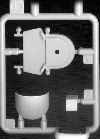 |
||||||||||||||||||||||||||||||||||||
|
|||||||||||||||||||||||||||||||||||||
| SPRUE M | |||||||||||||||||||||||||||||||||||||
| The larger 5" 38 gun platform is molded on this sprue along with some of the 20 mm platforms. | |||||||||||||||||||||||||||||||||||||
|
|||||||||||||||||||||||||||||||||||||
| SPRUE N x4 | |||||||||||||||||||||||||||||||||||||
| Once again Dragon used slide molding to allow maximum detailing to be included on each part. These Mk-51's are included with separate base and sight details and are the nicest available in plastic. |  |
||||||||||||||||||||||||||||||||||||
|
|||||||||||||||||||||||||||||||||||||
| SPRUE P | |||||||||||||||||||||||||||||||||||||
|
This is the 40 mm Quad mount that first appeared in the Gearing kit. Two complete mounts can be built from this sprue. It include separate twin barrel assemblies with nice flared out ends that even have simulated hollow ends and nice recoil springs. The base includes lots of detail with shell extraction chutes and detailed yoke and even some underside detailing. |
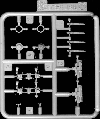 |
||||||||||||||||||||||||||||||||||||
|
|||||||||||||||||||||||||||||||||||||
| SPRUE Q x5 | |||||||||||||||||||||||||||||||||||||
| Five sprues of these 40 mm twin mounts are included. These are the same ones produced for the Tokyo Bar Buchanan and 1945 Benson. Each sprue builds two complete gun mounts. | 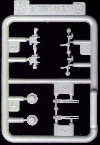 |
||||||||||||||||||||||||||||||||||||
|
|||||||||||||||||||||||||||||||||||||
| SPRUE R | |||||||||||||||||||||||||||||||||||||
| This sprue is newly tooled for Princeton and includes the different gun tubs that were unique to this ship. Some new island parts are included as well. A detail that was left out of the CVL-22 kit was the capstans from the bow. These are included on this sprue. |  |
||||||||||||||||||||||||||||||||||||
|
|||||||||||||||||||||||||||||||||||||
| SPRUE L x4 | |||||||||||||||||||||||||||||||||||||
| Three 20 mm twin sprues are included with these highly detailed guns. These feature separate shields, base, gun, ammo cans, and can be trained at any angle the real ones could. You don't have to use all the fine parts, but they are there if you want to. |  |
||||||||||||||||||||||||||||||||||||
|
|||||||||||||||||||||||||||||||||||||
| Sprue X | |||||||||||||||||||||||||||||||||||||
| The upper hull is nicely shaped and closely follows the lines of the Cleveland class with the distinctive torpedo blisters that were added for protection and stability. Dragon has taken extra care to eliminate sink marks and other molding defects. The hawsepipes on the bow are well done and you will notice the hull closely matches the plans. | |||||||||||||||||||||||||||||||||||||
|
|||||||||||||||||||||||||||||||||||||
| Sprue Y | |||||||||||||||||||||||||||||||||||||
| A single piece flight deck is included with very fine planing and tie down strips. This part is slide molded to allow for the bulkhead detailing to be molded seam free. The catapult and arrester gear details are molded onto the deck. While the detail is very nice on this deck, the biggest plus is the fact that it is a single part and the modeler has no big seams to fill. | |||||||||||||||||||||||||||||||||||||
|
|||||||||||||||||||||||||||||||||||||
| Sprue W | |||||||||||||||||||||||||||||||||||||
| The lower hull is nicely molded with the lines of a Cleveland class CL with the add on torpedo blister | |||||||||||||||||||||||||||||||||||||
|
|||||||||||||||||||||||||||||||||||||
| SPRUE Z | |||||||||||||||||||||||||||||||||||||
| A larger version of the stand that was designed for the Buchanan is included. Decorative posts are provided to hold your ship. These are a nice touch and you might note that there are extra hole locations in the bottom for future ships. | |||||||||||||||||||||||||||||||||||||
|
|||||||||||||||||||||||||||||||||||||
| AIRCRAFT | |||||||||||||||||||||||||||||||||||||
| SPRUE A&B F6F Hellcat x4 ea. | |||||||||||||||||||||||||||||||||||||
| There are three sprues of the Hellcat with fixed wings and three with folded wings. They are molded in clear plastic so that you can mask over the canopy and paint the rest of the aircraft. Underwing rockets and a nightfighter radar pod are also included. |  |
||||||||||||||||||||||||||||||||||||
|
|||||||||||||||||||||||||||||||||||||
| SPRUE D&E TBF Avenger x4 ea. | |||||||||||||||||||||||||||||||||||||
| TBF Avengers are molded with fixed and folded wing options. These two feature nice panel lines and separate cowling. Open and closed canopy options and as an added bonus a torpedo bay with open and closed door options. And if that is not enough, how about a scale torpedo to mount in the bay! A nice touch. |  |
||||||||||||||||||||||||||||||||||||
|
|||||||||||||||||||||||||||||||||||||
| PHOTOETCH | |||||||||||||||||||||||||||||||||||||
| Three brass photo etch frets are included in this kit. The first one features the add on details for the 20 mm and 40 mm gun mounts. Seats, sight, and hand wheels galore. Optional 20 mm gun shields are included if the modeler doesn't want to use the plastic ones. |  |
||||||||||||||||||||||||||||||||||||
| The second fret includes the railings, radar, and mast parts. Anchor chain, ladder stock, and a nice safety net are included. This one is new for the Princeton and has some ship specific details. | |||||||||||||||||||||||||||||||||||||
| The third fret includes the roll-up doors and the other hatches and doors if the modeler doesn't like the plastic ones. It's nice to have a choice! |  |
||||||||||||||||||||||||||||||||||||
| DECALS | |||||||||||||||||||||||||||||||||||||
| Flight deck markings are provided with some options. Yellow and white deck stripes and elevator markings are well registered. These are typical of the sharp work that Cartograph is known for. Flight deck numbers are included but may not be needed depending on what time frame you chose to model. An abundance of aircraft roundels of different types are included so you can accurately depict your airwing at almost any time in their career. | |||||||||||||||||||||||||||||||||||||
|
|||||||||||||||||||||||||||||||||||||
| A vinyl sheet is provided with US flags and a sampling of signal flags. These are also well registered and sharp. |  |
||||||||||||||||||||||||||||||||||||
| INSTRUCTIONS | |||||||||||||||||||||||||||||||||||||
| These instructions are ten pages with lot of subassembly views. These are a little more extensive than those supplied in the past and the extra views are a welcome addition. Note CVL-22 was in Measure 14 (Ocean Gray) on her shakedown and Measure 21 (Navy Blue) after that when she was operating in the Pacific. | |||||||||||||||||||||||||||||||||||||
|
|||||||||||||||||||||||||||||||||||||
| BONUS CREW MEMBERS | |||||||||||||||||||||||||||||||||||||
| Eighteen lifelike figures are included in a variety of poses. These guys should give you the option to add some action to your ships. I wish that more were included as they are extremely detailed. Each figure is in a different pose and if you look closely have the appropriate uniforms of that era. |  |
||||||||||||||||||||||||||||||||||||
|
|||||||||||||||||||||||||||||||||||||
| BUILDUP PHOTOS | |||||||||||||||||||||||||||||||||||||
| These are photos of Dragon's unpainted display model. They will give you a good idea of how detailed the parts are. |  |
||||||||||||||||||||||||||||||||||||
|
|||||||||||||||||||||||||||||||||||||
| CONCLUSIONS | |||||||||||||||||||||||||||||||||||||

A nice follow-up to the ground breaking Independence, this sistership continues the successful Smart Kit line. A few of the CAD parts were done by me so my opinions may be a bit biased, but don't take my word for it take a look at the photos and judge for yourself. The Princeton has a storied history and I am excited that Dragon is now offering this famous ship in 350 scale. This is kit #DRA1055 1/350 U.S.S. Princeton CVL-23 Smart Kit has a price of around $149.50 as of February 2012. A great price for the hours of modeling enjoyment included in this kit. |
|||||||||||||||||||||||||||||||||||||
 |
|||||||||||||||||||||||||||||||||||||
